The Best NVMe SSD for Laptops and Notebooks: SK hynix Gold P31 1TB SSD Reviewed
by Billy Tallis on August 27, 2020 8:00 AM ESTSequential Read Performance
Our first test of sequential read performance uses short bursts of 128MB, issued as 128kB operations with no queuing. The test averages performance across eight bursts for a total of 1GB of data transferred from a drive containing 16GB of data. Between each burst the drive is given enough idle time to keep the overall duty cycle at 20%.
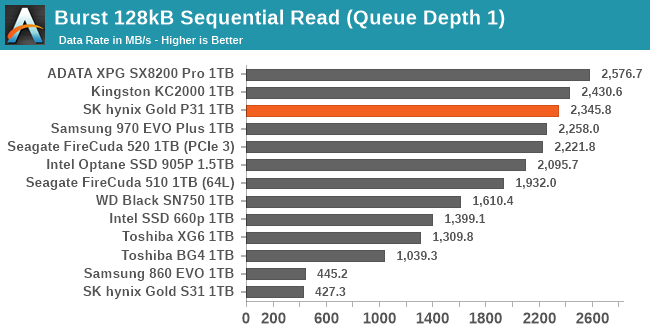
The burst sequential read performance from the SK hynix Gold P31 is very good, but not quite fast enough to beat the drives based on the Silicon Motion SM2262EN controller.
Our test of sustained sequential reads uses queue depths from 1 to 32, with the performance and power scores computed as the average of QD1, QD2 and QD4. Each queue depth is tested for up to one minute or 32GB transferred, from a drive containing 64GB of data. This test is run twice: once with the drive prepared by sequentially writing the test data, and again after the random write test has mixed things up, causing fragmentation inside the SSD that isn't visible to the OS. These two scores represent the two extremes of how the drive would perform under real-world usage, where wear leveling and modifications to some existing data will create some internal fragmentation that degrades performance, but usually not to the extent shown here.
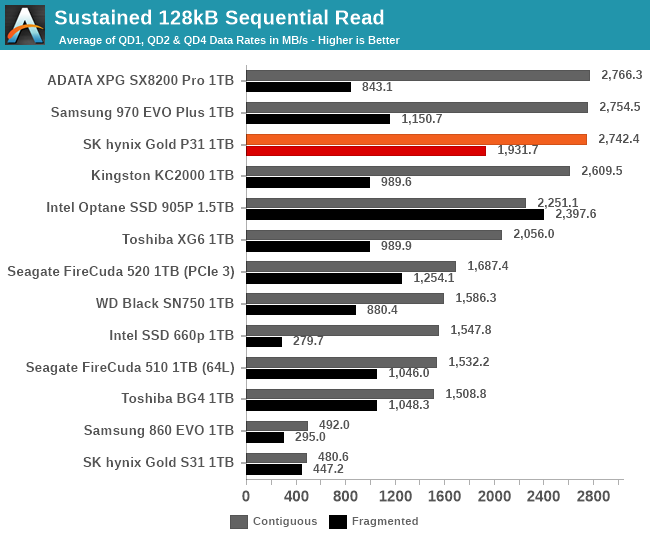
On the longer sequential read test that involves some slightly higher queue depths, the Gold P31 is basically tied for first place when reading data that was written sequentially. When reading data that has previously been fragmented by the random write test, the P31's performance is considerably higher than the other flash-based SSDs and closer to the Optane 905P.
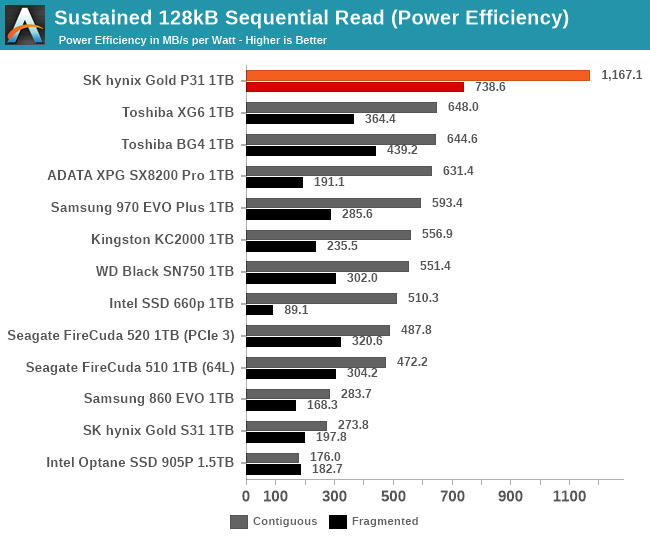 |
|||||||||
| Power Efficiency in MB/s/W | Average Power in W | ||||||||
In absolute terms, the power consumption of the Gold P31 isn't drastically lower than some of the other fairly efficient high-end NVMe drives like the WD Black SN750. But once performance is taken into account, the Gold P31's efficiency stands far above the competition.
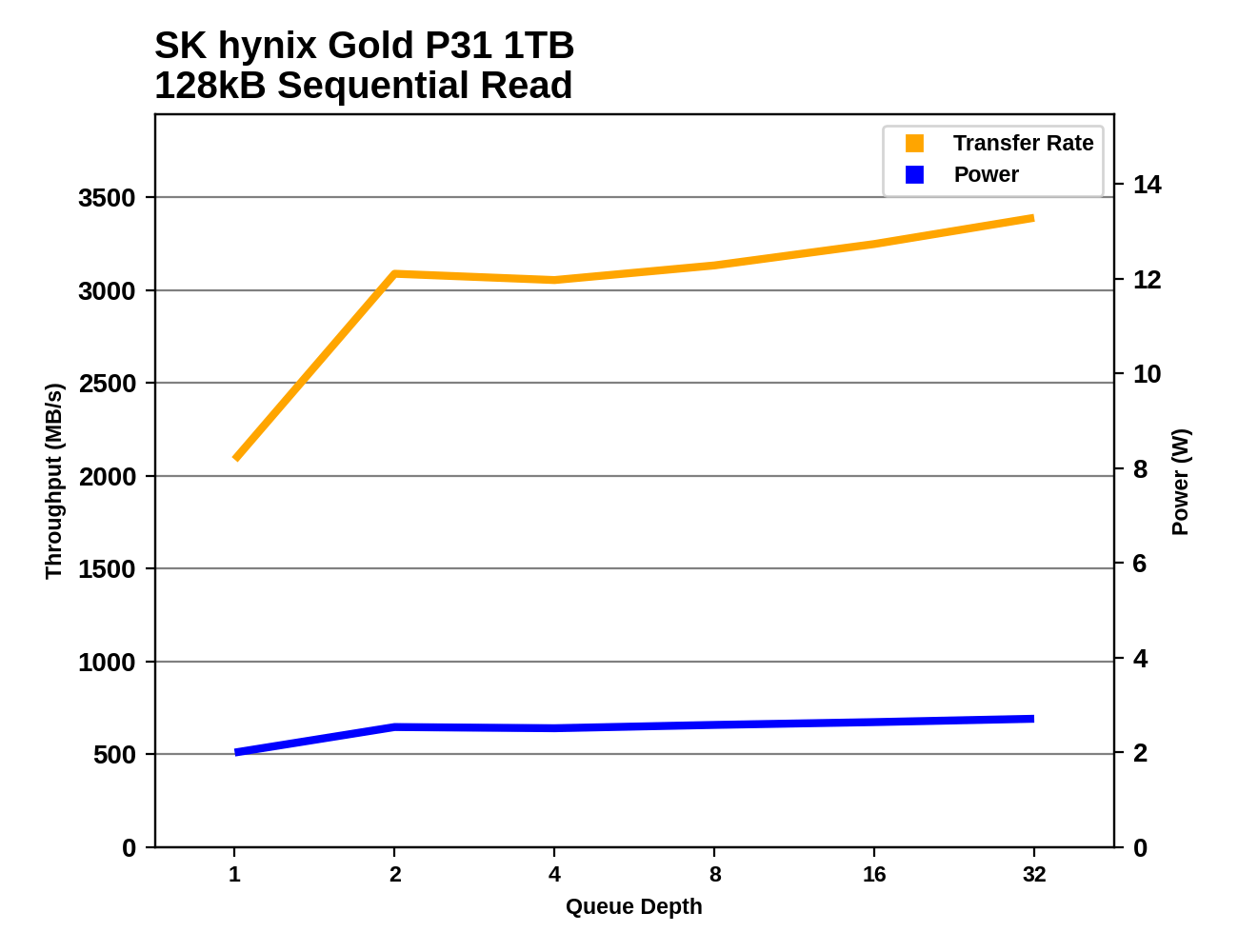 |
|||||||||
The SK hynix Gold P31 doesn't need high queue depths to deliver good sequential read throughput: at QD2 it's already above 3 GB/s, but there are further slight performance increases from higher queue depths. That performance profile is very similar to the Samsung 970 EVO Plus, but that drive requires about twice the power that the P31 uses.
Even at QD1, the sequential read performance from the Gold P31 is above the ~2GB/s limit of most other four-channel NVMe drives we've tested (with eg. Silicon Motion SM2263 based controllers). That leaves it entirely in a performance range where all the competitors are 8-channel drives that don't come close to matching power efficiency of the Gold P31.
Sequential Write Performance
Our test of sequential write burst performance is structured identically to the sequential read burst performance test save for the direction of the data transfer. Each burst writes 128MB as 128kB operations issued at QD1, for a total of 1GB of data written to a drive containing 16GB of data.
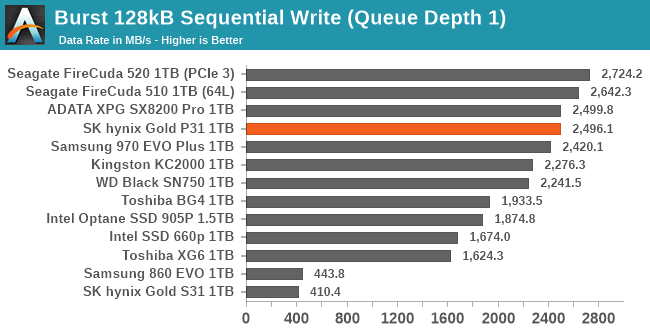
The SK hynix Gold P31 has fairly ordinary burst sequential write performance by high-end NVMe standards: tied with the SM2262EN-based ATATA SX8200 Pro but beat by the Phison-based Seagate drives.
Our test of sustained sequential writes is structured identically to our sustained sequential read test, save for the direction of the data transfers. Queue depths range from 1 to 32 and each queue depth is tested for up to one minute or 32GB, followed by up to one minute of idle time for the drive to cool off and perform garbage collection. The test is confined to a 64GB span of the drive.
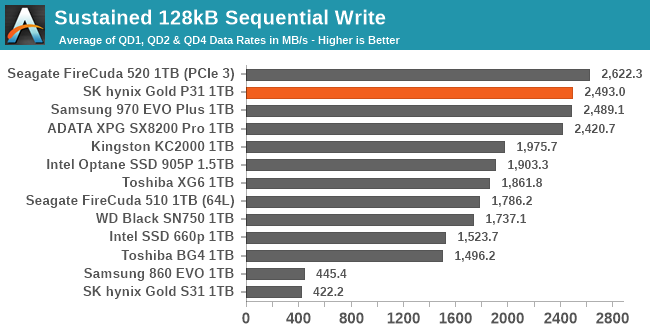
On the longer sequential write test that brings in higher queue depths, the Gold P31 is tied for second place, while the Phison E16 based Seagate drive (built for PCIe 4 speeds, but limited by this testbed to PCIe 3 speeds) unsurprisingly takes first place.
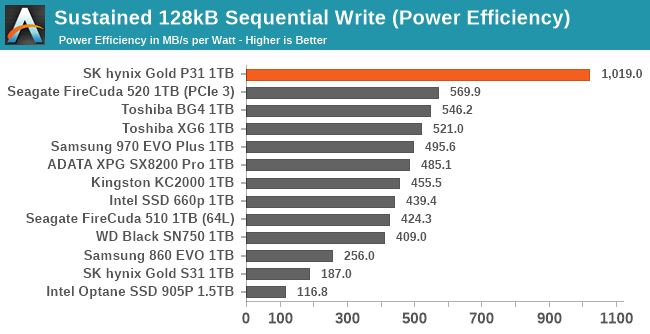 |
|||||||||
| Power Efficiency in MB/s/W | Average Power in W | ||||||||
At this point, the record-shattering power efficiency scores from the SK hynix Gold P31 are no longer a surprise. The overall fastest drive has the second best efficiency score (56% the performance per Watt of the P31) and the next two most efficient drives are much slower NVMe drives from Toshiba/Kioxia.
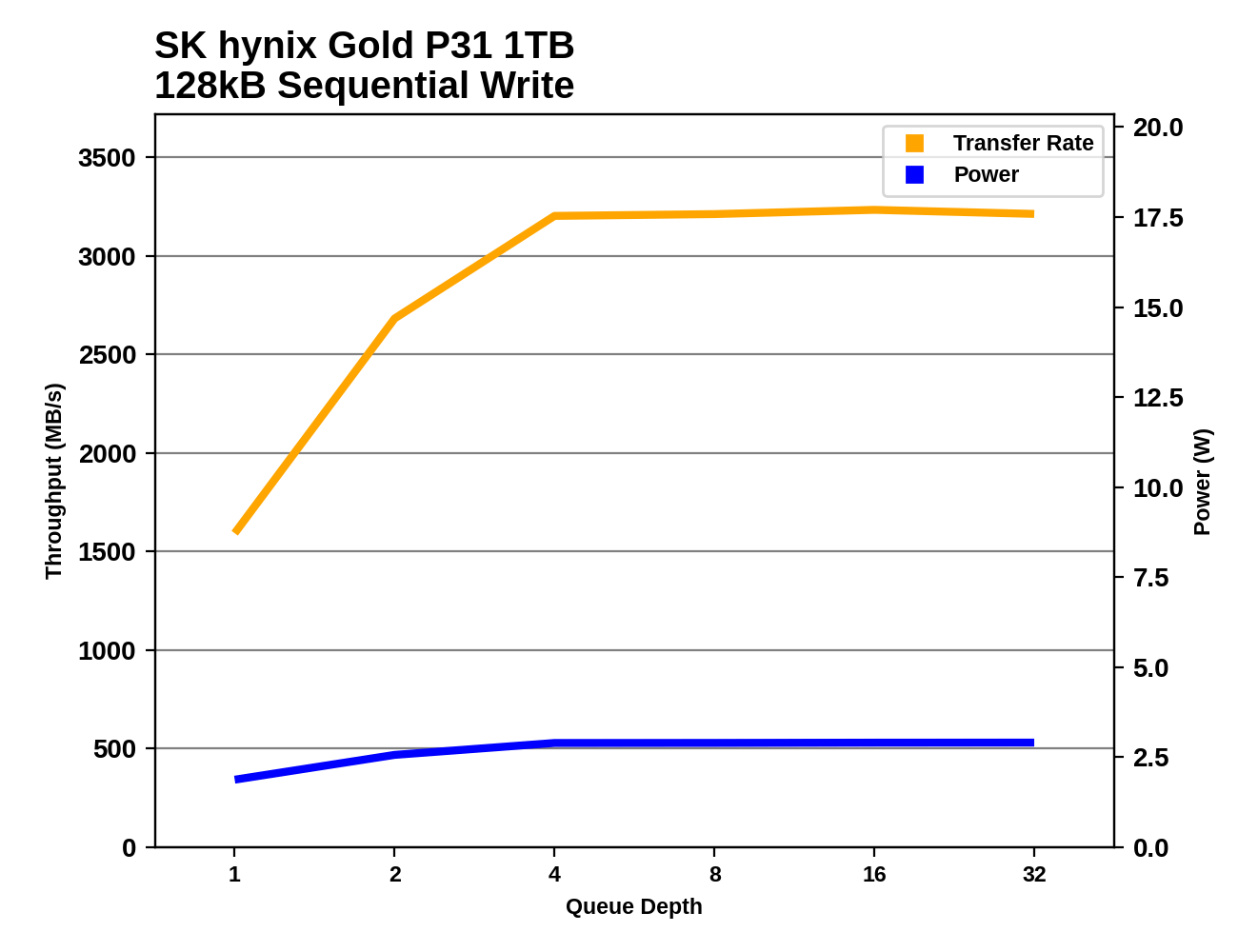 |
|||||||||
The Gold P31 doesn't reach its full sequential write speed until QD4, while several of its competitors saturate at QD2. However, once the P31 is at full speed, it has one of the best sustained write speeds, and shows no sign of its SLC cache running out at any point during the test. Power consumption is comparable to the slowest NVMe drive that can barely hit half the throughput of the Gold P31.
Similar to the sequential read results, the P31 starts out at QD1 with high performance that almost puts it beyond what other 4-channel NVMe drives can do at any queue depth. From there, the P31 continues to redefine what's possible with an increasingly wide lead in power consumption relative to all other high-end drives we've tested.


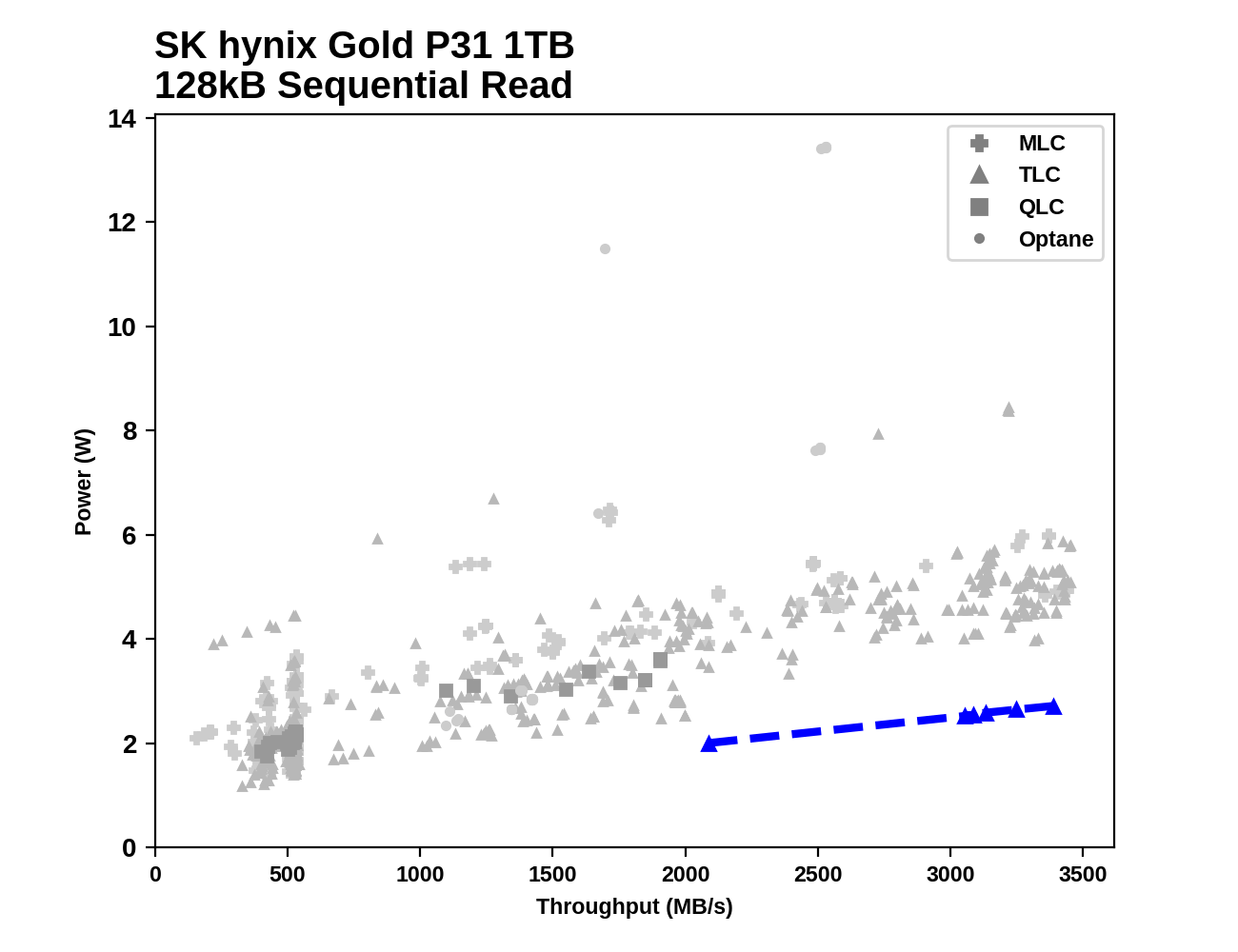









80 Comments
View All Comments
TheinsanegamerN - Thursday, August 27, 2020 - link
Looks like a fantastic laptop drive.Now, if only we could get some nice 4800/4850U laptops to go with it.
Walkeer - Friday, August 28, 2020 - link
there is one: schenker via 15 pro / tuxedo: https://www.tuxedocomputers.com/en/Linux-Hardware/...TheinsanegamerN - Monday, August 31, 2020 - link
that's a 4800h, not a 4800u. The 4800U has 8 GPU slices, the 4850U has 9. The 4800h has the same GPu performance as a 4700u, as both have 7 slices.It's confusing. The analog for H series would be a 4900h. I saw that laptop earlier and it would be perfect if it had a 4900h and lpddr4x, but alas it does not.
Luminar - Thursday, August 27, 2020 - link
There are barely any 2242 drives on the market. Wish there were more.vladx - Thursday, August 27, 2020 - link
Very few motherboards including for laptops are limited to 2242 size. The only real use case would be tablets, sadly that market is in a steep decline.Luminar - Thursday, August 27, 2020 - link
Many laptops use the 2242 form factor. All Thinkpads do, at least for the secondary drive slot.Finding a 2242 was difficult so I had to Dremel down a 2280 drive to the 2242 form factor.
TheinsanegamerN - Friday, August 28, 2020 - link
Uh huh. So you cut a 2280 drive down to size and got a nice light show? Because you cant just dremel off a flash NAND chip and expect the drive to work properly....Luminar - Friday, August 28, 2020 - link
Of course you can Dremel off a good amount of the WD SN500/520 series of drives. As AnandTech wrote in their review, the electronics are contained in the first 30mm of the PCB for all SN500 drives, whether they be 2280, 2242, or 2230.TheinsanegamerN - Monday, August 31, 2020 - link
OK, fair enough theSN500syou can do that. I've never seen a M.2 drive like that befor,e they've always had chips along the entire 80mm length.cfbcfb - Sunday, August 30, 2020 - link
Yeah, you have to fold it over and use some duct tape on it.A computer without at least one piece of duct tape is just not cutting it.